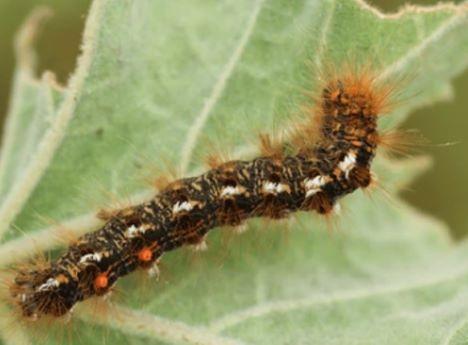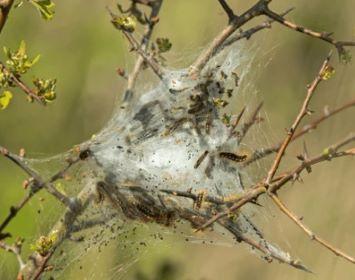Brown Tail Moth advice
How to identify the Caterpillar:
The caterpillar or larval stage of the Brown Tail Moth (Euproctis chrysorrhoea) is dark brown with a dotted white line down each side of its back. It has two prominent red dots on the back of its tail. It is also clothed with long yellowish - brown hairs.

Why is there concern about the Brown Tail Moth?
The irritant hairs of the caterpillar are shed and may be blown in the wind. Washing hung out to dry can collect these hairs as well as articles left in the garden. Wearing clothes or handling articles to which hairs from a caterpillar have become attached may subsequently lead to skin irritation.
Can the skin irritation be treated?
The irritant rash normally lasts 2 to 3 days. Advice about alleviation of this condition may be obtained from your local pharmacist. Persons with pre-existing skin conditions, young children and those who suffer from allergic reactions may need to obtain medical advice from their GP.
When do the caterpillars appear?
The caterpillars first appear toward the end of August and September when they emerge from their silken webs to feed during warm autumn days. After a period of hibernation the caterpillars begin to reappear in the following April as soon as warm sunny weather occurs. The most likely period of contact with the unsuspecting is in May and June when the caterpillars forage further from their cocoons.
Which shrubs and trees are likely to be affected?
The caterpillars can cause complete foliage loss of a wide variety of shrubs and trees including hawthorn, blackthorn, apple, pear, plum and ornamental cherries.
How to identify and treat an infestation? During the winter months when trees are bare the hibernation quarters of the caterpillar, the white and brown silken webs, also known as “tents”, which they have spun at the tips of branches, are easily seen.

At this time, between November and March, the webs should be cut out and burnt. In many cases removal of webs can be combined with a winter pruning of fruit trees and hard trimming back of hedges.
When are the best times to spray? What safety precautions should be followed?
Insecticide spraying can be carried out once the caterpillar emerges from the tent during still, dry days (no rain or wind) from April to June and later on between August and October. Suitable insecticides approved under the Pesticide Safety Precaution Scheme can be obtained from garden centres and other retail outlets.
- Read and follow the manufacturer's instructions when using chemicals;
- Wear the recommended protective clothing, e.g. goggles, or face shield, and gloves
- Avoid spray drift in the air, onto other plants or onto neighbouring properties
- Check that your ladder is safe for you and anyone below;
- Wash all clothing thoroughly to remove chemicals and irritant hairs
Where can horticultural advice be obtained?
Gardeners concerned with the effect upon a particular plant species of either pruning or spraying should seek advice from a local horticulturist, the Royal Horticultural Society, or the insecticide manufacturer.
What should I do if I see brown tail moth caterpillars on trees or shrubs in the street or open space, or on someone else’s property?
- Let your neighbours know if you see these caterpillars on their property;
- Or, contact Regulatory Services on telephone 01474 337000. We will ensure that whoever is responsible for the land is notified and offered appropriate advice.

